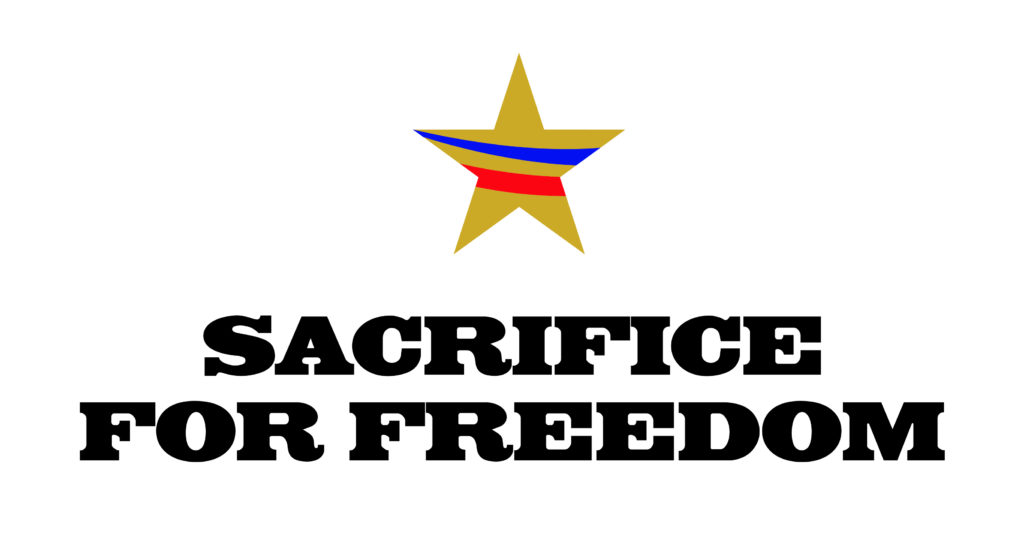Mess Attendant First Class Gregorio San Nicolas Aguon
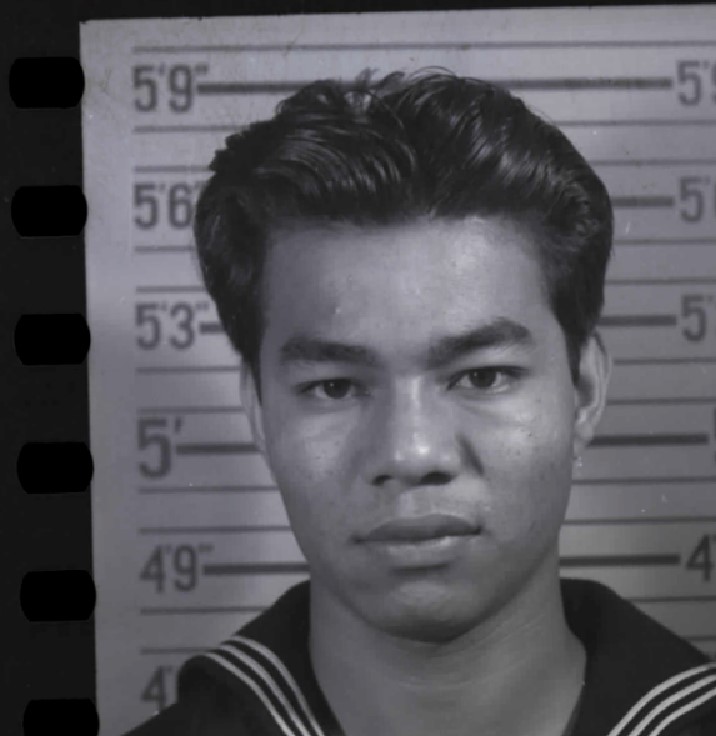
- Unit: USS Arizona
- Service Number: 421038
- Date of Birth: October 10, 1920
- Entered the Military: December 2, 1938
- Date of Death: December 7, 1941
- Hometown: Hagatña (Agana), Guam
- Place of Death: USS Arizona, Pearl Harbor, Hawaiʻi
- Award(s): Purple Heart
Mentored by Mr. Brian Paul Galang
Father Dueñas Memorial School
2022/2023
Early Life
Gregorio San Nicolas Aguon was born on October 10, 1920, to parents Juan Torres Aguon and Joaquina San Nicolas Aguon. He was the eldest sibling to Cristobal, Juan, Eugenio San Nicolas Aguon, Fidela Aguon Paco, and Elenita Aguon Santos.
Not many factual details were known about Gregorio San Nicolas Aguon’s childhood. But as a member of the CHamoru culture, like other boys and girls, he would join agricultural clubs, a significant aspect of the CHamoru culture. There were copra, corn, calf, garden, rice, bean, horticulture, root crop, and poultry clubs. These clubs would be dependent on the village in which they lived. For instance, the copra club was designated in the village of Talofofo. Each respective club would have a leader and supervisor with whom they would organize projects. There was competition amongst the clubs, wherein their projects were scored. Awards were given to the winning club activity.
Young people such as Aguon also participated in local sports. Baseball, basketball, and volleyball leagues were created. Baseball was especially popular amongst CHamoru boys. Its popularity began when the Americans brought it to the island. The formation of the Junior and Senior leagues or teams were also based on the village, just like with the clubs.
During the U.S. Naval Era on Guam (1944–1950), Governor George Leland Dyer issued General Order No. 80 stated “All children shall attend the Public Schools when in session in the municipal district in which said children are registered.” Aguon attended school up to the eighth grade, though which one is not known. After finishing primary education, high school was not mandatory, so he worked as a farmer like his father. It was common for CHamorros to take on the parents’ work.
Homefront
Mess Attendant First Class Gregorio San Nicolas Aguon lived in the Capital of Guam, Hagatña. The village, located in central Guam, was nestled in between Agana Bay and the cliffs of Agana Heights. An estimated 1,000 people resided in the village, with a little over 200 dwellings: 53 belonged to upper-class families and 150 from the lower caste.
The balangai or gupot higai was an intricate part of the traditional chenchule’ (social reciprocity) network amongst the CHamoru. It was a community activity wherein members would come together to assist a family in need of fixing the roof of their house. People would bring higai or thatch and complete the roofing of their neighbor in need. In exchange, one day, when one needed their roof to be thatched, he could be sure that the whole community would take care of him.
Japanese occupation during World War II destroyed houses, private and public buildings, and a number of structures with historical significance. Japan invaded Guam because of its water and land sources, and to serve as a supply base for the transit of Japanese military ships. CHamorus were conscripted into the war effort without regard to their safety and well-being. Most men were forced to construct the two operational airstrips at Orote and Jalaguac, or at the new one developed in the island’s northeastern corner. Some younger men built pillboxes and man-made caves, installed real and dummy cannons at coastal areas, and transported food and ammunition to key defense outposts. The women planted and harvested farm crops. In the south, CHamoru men were ordered to lay large tree trunks across the road, place rocks along the beach to block an invasion, and dig large holes to slow down the American tanks.
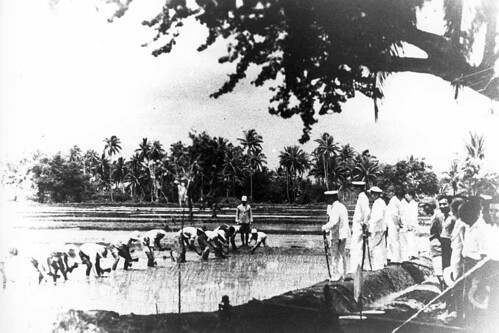
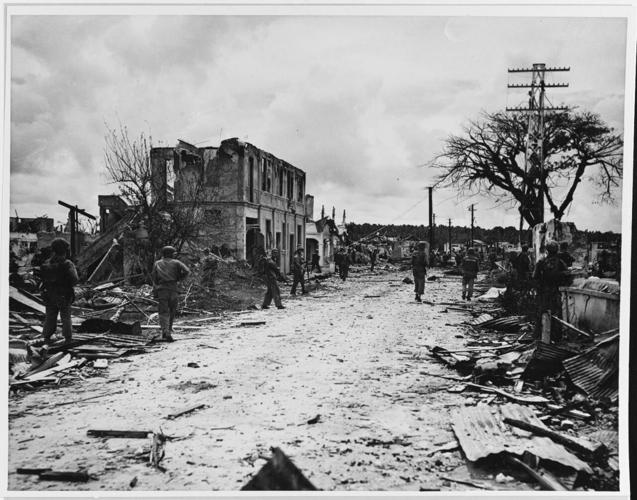
Military Experience
Gregorio San Nicolas Aguon enlisted in the U.S. Navy on December 2, 1938, at the age of 18. On January 30, 1939, Aguon completed his military training at Naval Station Guam, was transferred to the USS Barnes, and received on the USS Henderson before being transferred to the USS San Francisco for general detailing. Aguon was transferred to the USS Arizona on April 30, 1939, received on the USS West Virginia on February 3, 1940, and returned to the USS Arizona for permanent service on November 18, 1941.
Aguon’s initial enlisted rank was Mess Attendant Third Class. On December 16, 1939, with one year of Naval Service, Aguon passed the examination for advancement in rating to be Mess Attendant Second Class with an average mark of 3.47. He was then examined on December 17, 1940 and passed the examination with an average mark of 3.13. He became a Mess Attendant First Class on February 16, 1941.
By order of President Franklin D. Roosevelt, the USS Arizona and other ships of the Pacific Fleet battleships were moved to Pearl Harbor, Hawai’i.In August 1941, the USS Arizona with Aguon aboard returned to the Pacific, continuing operations with the Battle Fleet. Like many others from Guam, Mess Attendant First Class Gregorio San Nicolas Aguon worked in the galley, facing segregation and limited opportunities in a time of racial inequality. Mess Attendant was the only rank that CHamorros were allowed to have. Mess Attendant Aguon’s duties included serving food to officers and crew aboard the ship, preparing hot and cold drinks and fruits, for serving, and setting tables for meals.
On December 7, 1941, the Japanese attack on Pearl Harbor. Mess Attendant First Class Gregorio San Nicolas Aguon was on board the USS Arizona when eight armor-piercing bombs struck the battleship. One penetrated the Arizona’s deck near its No. 2 turret, causing a large explosion on the front of the ship. Aguon was Killed In Action and was buried in the wreckage of the USS Arizona.
Dated January 8, 1945, Mess Attendant First Class Gregorio San Nicolas Aguon’s parents, Juan Torres Aguon and Joaquina San Nicolas Aguon wrote a letter to the Honorable Chief of Bureau of Personnel stating:
“Sir:
Our Son, Gregorio San Nicolas Aguon, enlisted in the United States Navy on 1 December, 1939, as a Mess Attendant 3rd Class at the U.S. Naval Station, Guam, and, as we understand it, he was transferred therefrom for duty with the Fleet.
Inasmuch as we have not heard from him since the year 1940 and the fact that no official information has as yet been received as to his present whereabouts, we, as parents, respectfully appeal for the kind consideration of the Honorable Chief of the Bureau of Personnel in furnishing the undersigned necessary information as to the present status of our son.
The last we heard of him was that he was serving on board the U.S.S. Arizona. Any information furnished in this regard will be greatly appreciated.”
A letter dated February 15, 1945, Chief of Naval Personnel H. B. Atkinson informed Aguon’s parents of the tragedy that happened. “The Navy Department deeply regrets to inform you that your son was killed in action on 7 December 1941. He was serving on board the USS Arizona when that vessel was sunk during the Japanese Attack at Pearl Harbor, T.H. His body was recovered.” Another letter dated October 20, 1948 was sent from M. Lanham informing his parents that Aguon posthumously received the following awards: World War II Victory Medal, American Campaign Medal, Asiatic-Pacific Campaign Medal, and a Good Conduct Medal.
Mess Attendant First Class Gregorio San Nicolas Aguon was memorialized at the Pearl Harbor USS Arizona Memorial and at the Courts of Missing, Court 5, National Memorial Cemetery of the Pacific, Honolulu Hawaiʻi.
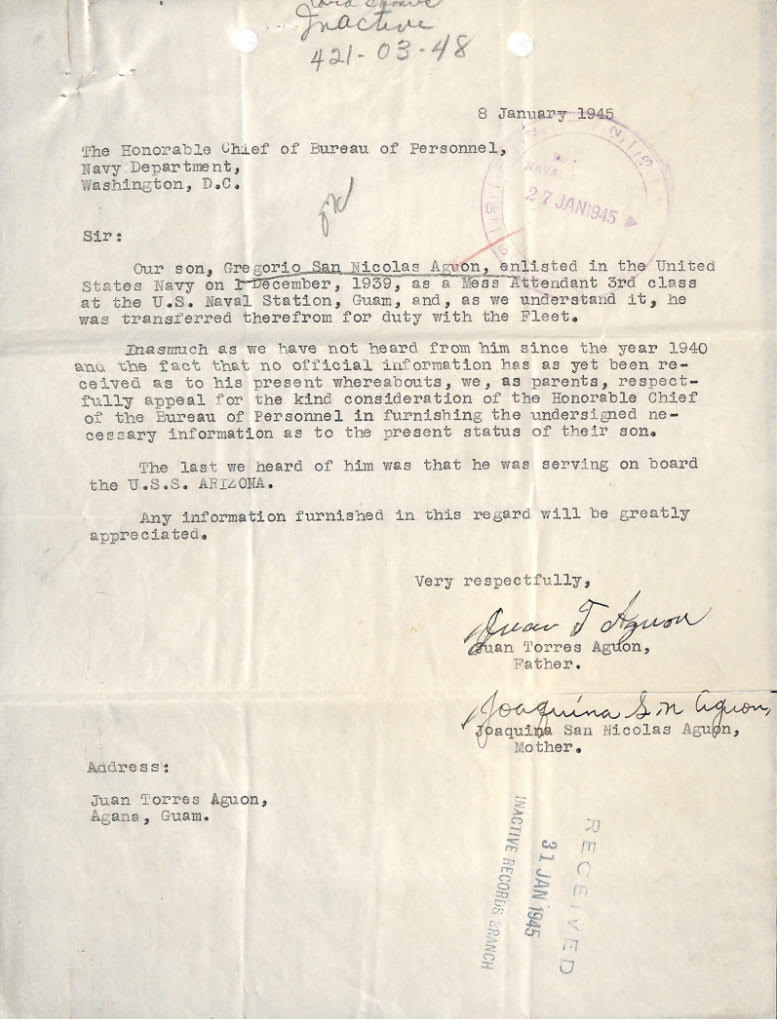
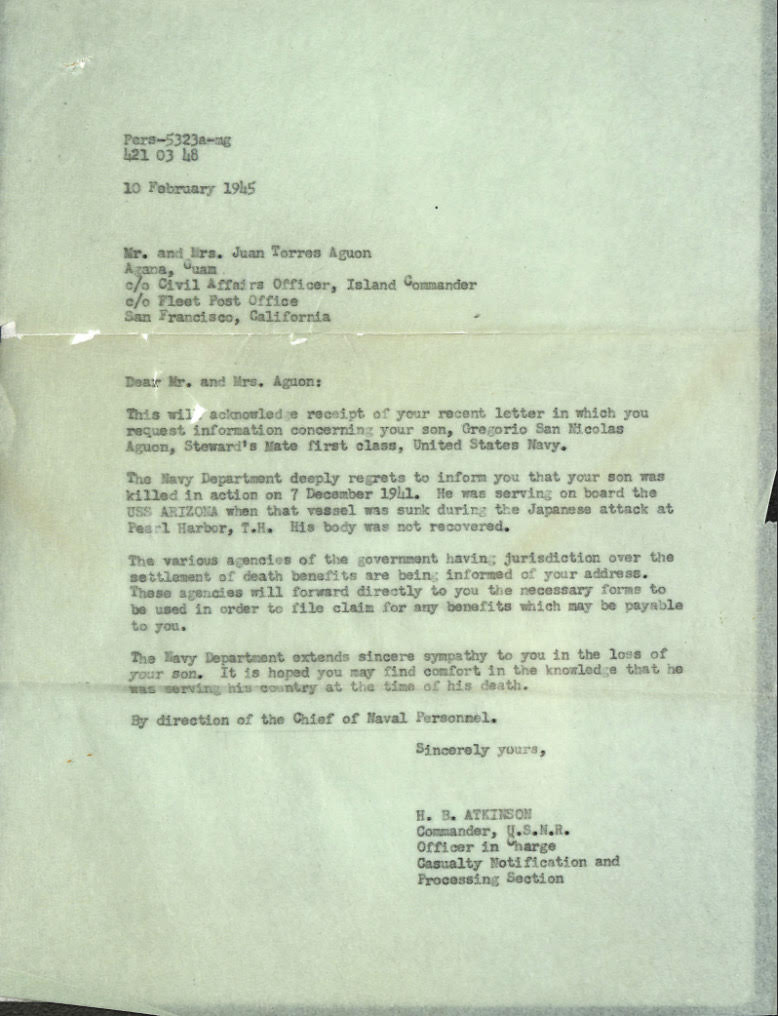
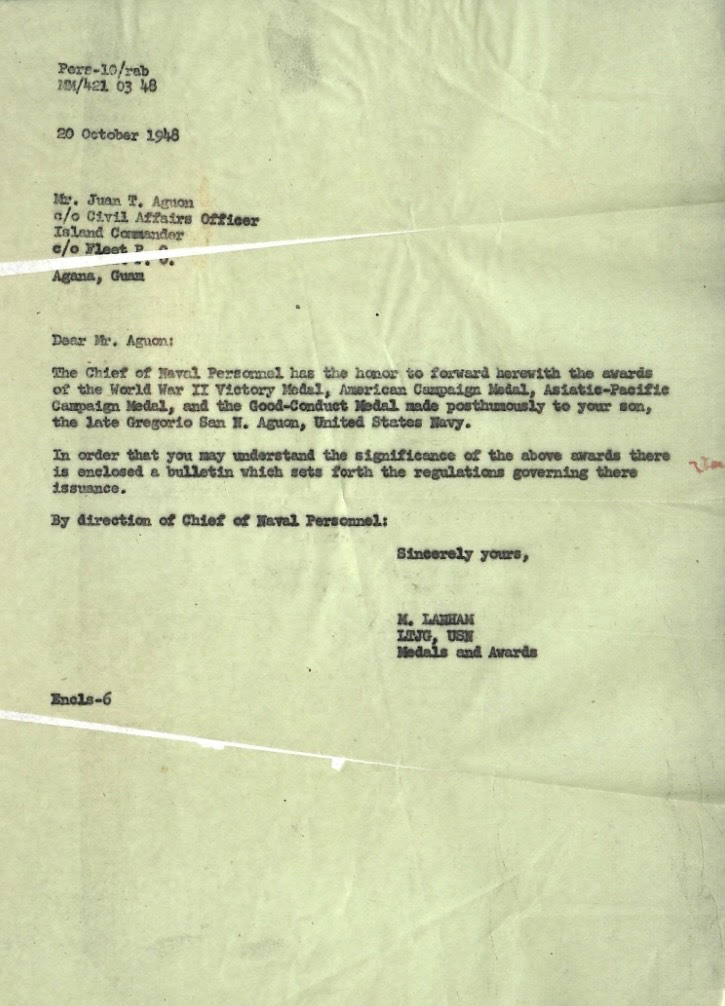
Eulogy
On December 6, 1941, Mess Attendant First Class Gregorio San Nicholas Aguon and his friend, Sonar Technician Third Class Henry Mesa Cruz, a fellow CHamoru, decided to have a night of fun because it was payday weekend. They decided to get tattoos. As Cruz told the story to a Los Angeles Times reporter, he got an eagle on his left shoulder with “USS Arizona and Dec. 7, 1941.” He could not remember, though, Aguon’s tattoo. They caught a 2 a.m. ride back to the battleship. Just before 8 a.m., Cruz headed back to Honolulu, but Aguon stayed on board because he felt sick.
On that fateful morning, etched in the lives of countless individuals, the Japanese Imperial forces attacked Pearl Harbor. Over 100 ships were stationed at Pearl Harbor, of which eight battleships became primary targets, the USS Arizona (BB-39) being one of them. Over 1,100 sailors and Marines perished in the USS Arizona.
As we reflect on the events of the attack on Pearl Harbor, we should always remember the heroism displayed by countless individuals like Mess Attendant First Class Gregorio San Nicholas Aguon. May we honor their legacy by living righteous lives, valuing peace, and promoting unity in the world.
In agradesi hao Mess Attendant First Class Gregorio San Nicholas Aguon para i geftao na bida-mu. I Sakrifisio-mu ha na’guahayi ham ni linibre ni in gogosa pa’go. Para bai in agradesi hao todu i tiempo.
(We thank you, Mess Attendant First Class Gregorio San Nicholas Aguon for your selfless act. Your sacrifice provided for us the freedom we have today. We are forever grateful.)
Si Yu’Os Ma’åse, Mess Attendant First Class Gregorio San Nicholas Aguon. You are a true CHamoru warrior and an American patriot. Rest easy, rest in peace, you are not forgotten.
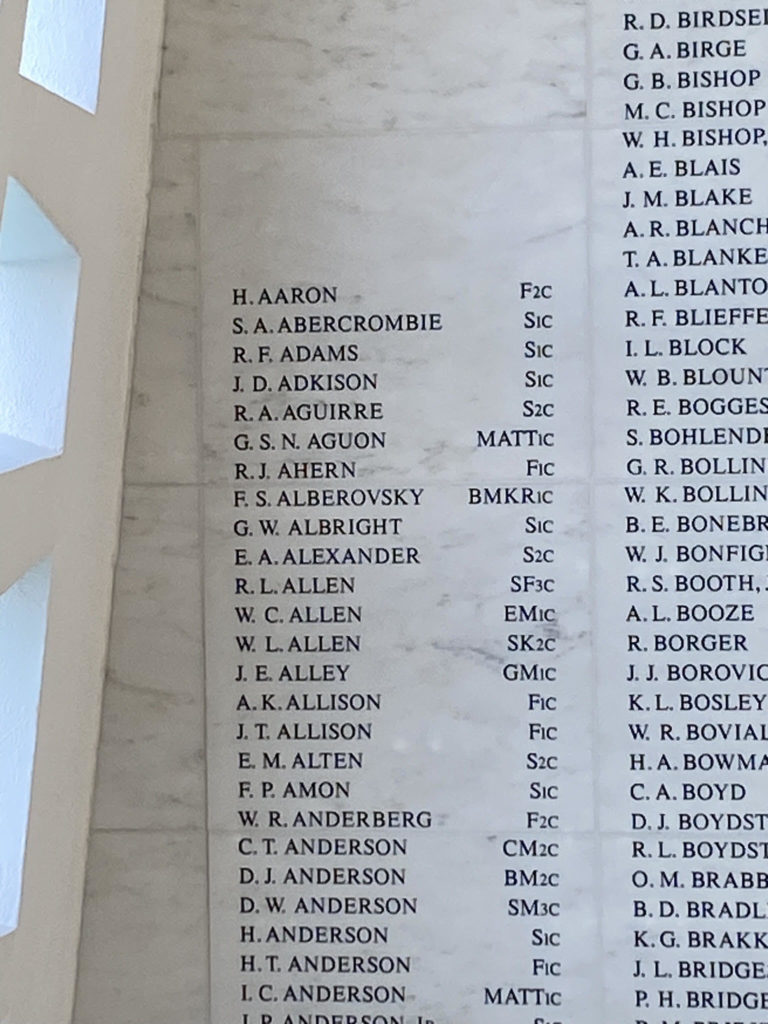
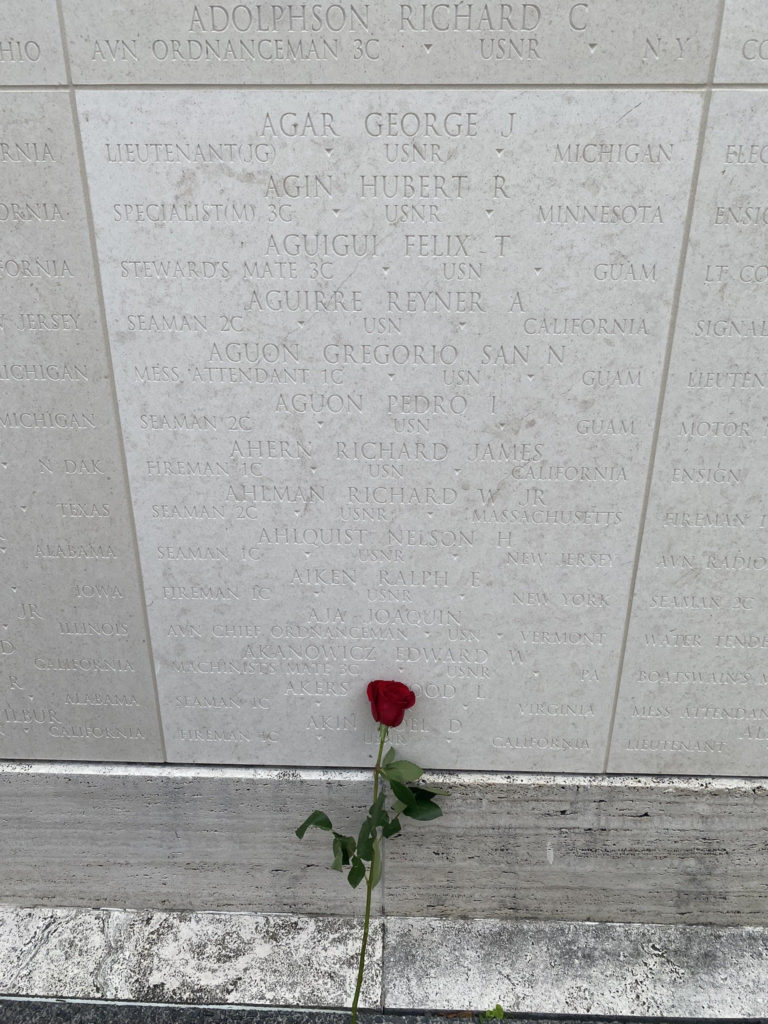
Reflection
All our hard work and dedication culminated in the live program Sacrifice for Freedom®: World War II in the Pacific Student and Teacher Institute in Hawaiʻi. It was an amazing and emotional experience. To have walked and visited the Pacific Theater sites in Hawaiʻii was something that not most people can be able to say. Highlights of my trip include the hike to Diamond Head State Monument, sleeping on the USS Missouri, and visiting the Japanese Cultural Center. All of the tour guides had the Aloha spirit. I felt their admiration and enthusiasm for the places that they were presenting us. Each day had its own uniqueness. This program had a great way of presenting Hawaiʻi, its part in World War II, its scenery through the eyes of a tourist, and the past to young historians like myself.
The assignments and readings prior to the live program were eye-opening, necessary, and relative to the importance of the program. The readings contained information that I have not come across. It was quite intriguing as I learned more about Hawaiʻi, its culture, and the war in the Pacific. Furthermore, it was a good way to read about the places that we were going to be visiting and how they played a part during World War II. The Silent Hero research was definitely a difficult journey because there were parts of my hero’s life that we were not able to uncover. However, I learned to use context clues of the time period to put it together.
The Silent Hero graphic organizers were very helpful because it was easy to refer to and it made the process of writing the eulogy easier. The eulogy process was fulfilling in that we were able to use what we found to finally recognize our Silent Hero. Writing the eulogy was not as hard as I thought it would be because, through research, I had a connection to our Silent Hero. Moving forward, I take back the little details that happened behind the bigger picture of World War II in the Pacific. I plan to share the fun experiences, and, as well, teach others something they may have not known about the war.
Bibliography
Primary Sources
CHamoru men, in pre-World War II Guam brining higain or thatch via bullcart to balangai or gupot higai. Photograph. Guam Museum Foundation. Accessed July 21, 2023. https://www.guammuseumfoundation.org/2022/02/09/chamoru-men-in-pre-world-war-ii-guam-bringing-higai/.
Chamorros in Asan rice paddies with Japanese military personnel monitoring. Photograph. National Park Service (WAPA -043). Accessed August 22, 2023. http://npshistory.com/publications/wapa/npswapa/gallery/albums/Occupation/63_ricepaddy_occptn.htm.
Gregorio San Nicolas Aguon, Official Military Personnel File, Department of the Navy, Records of the Bureau of Naval Personnel, RG 24, National Archives and Records Administration – St. Louis.
Gregorio S.N. Aguon. World War II U.S. Navy Muster Rolls, 1938-1949. Digital images. https://www.ancestryclassroom.com/.
Gregorio San N. Aguon. World War II Navy, Marine Corps, and Coast Guard Casualties, 1941-1945. Digital Images. https://www.ancestryclassroom.com/.
Gregorio San Nicolas Aguon, Individual Deceased Personnel File, Department of the Army.
Guam. Agana. 1930 U.S. Census. Digital Images. https://www.ancestryclassroom.com/.
Guam. Agana. 1940 U.S. Census. Digital Images. https://www.ancestryclassroom.com/.
Marines enter the ruins of Agana. Photograph. July 31, 1944. U.S. Marine Corps. https://www.guampdn.com/news/local/after-years-of-suffering-a-three-week-battle-ended-japanese-occupation-of-guam/article_903de8bb-7824-5bec-a874-8770276253a0.html.
Nease, N. A. “AGUON, Gregorio San Nicholas – MAtt1/c USN – Guam.” USSArizona.org. Accessed July 21, 2023. https://www.ussarizona.org/individual-profiles/uss-arizona-casualty-profiles/aguon-gregorio-san-nicholas-matt1c-usn-guam.
Secondary Sources
“Aguon, Gregorio SanNicholas, S1C.” Fold3. https://www.fold3.com/.
“Gregorio San N. Aguon.” American Battle Monuments Commission. Accessed July 20, 2023 https://www.abmc.gov/decedent-search/aguon%3Dgregorio
“Gregorio San Nicholas Aguon.” Find a Grave. Last modified March 15, 2014. Accessed July 21, 2023. https://www.findagrave.com/memorial/126362914/gregorio-san_nicholas-aguon#source.
Higuchi, Wakako. “Japanese occupation of Guam.” Guampedia. Last modified January 12, 2023. Accessed July 21, 2023. https://www.guampedia.com/japanese-occupation-of-guam/.
Leon-Guerrero, Jillette. “Hagåtña.” Guampedia. Last modified on March 14, 2023. Accessed April 7, 2023. https://www.guampedia.com/hagatna/.
“MA1 Gregorio San Nicolas Aguon.” Defense POW/MIA Accounting Agency. Accessed July 23, 2023. https://dpaa-mil.sites.crmforce.mil/dpaaProfile?id=a0Jt000000mpi5AEAQ.
Murphy, Marilyn. “Gregorio San Nicolas Aguon.” TogetherWeServed. Accessed July 21, 2023. https://navy.togetherweserved.com/servlet/tws.webapp.WebApp?cmd=LegacySBV&type=Person&ID=299611.
Palomo, Tony and Katherine Aguon, Ph.D. “WWII: From Liberation to Occupation.” Guampedia. Last modified on March 13, 2023. Accessed April 7, 2023. https://www.guampedia.com/wwii-from-occupation-to-liberation/.
Pollock, Nancy J. “Food Habits In Guam Over 500 Years.” Pacific Viewpoint 27, no. 2 (October 1986): 120-143. https://onlinelibrary.wiley.com/doi/pdf/10.1111/apv.272002.
Siguenza, Lorenzo T. “Boys’ and Girls’ Agricultural Clubs.” The Guam Recorder, April 10, 1940. https://www.guampedia.com/guam-recorder-1924-1940/.
Thompson, Laura. “Guam and Its People.” Guam Museum Foundation. Accessed July 21, 2023. https://www.guammuseumfoundation.org/2023/04/11/pre-world-war-ii-study-of-the-chamoru-people-titled-guam-and-its-people/.
Underwood, Robert A. “Education during the US Naval Era.” Guampedia. Last modified February 7, 2023. Accessed July 21, 2023. https://www.guampedia.com/u-s-naval-era-education/.
“USS Arizona during the Pearl Harbor Attack.” Naval History and Heritage Command. Accessed July 21, 2023. https://www.history.navy.mil/our-collections/photography/wars-and-events/world-war-ii/pearl-harbor-raid/battleship-row-during-the-pearl-harbor-attack/uss-arizona-during-the-pearl-harbor-attack.html.
Williams, Dana. “After years of suffering, a three-week battle ended Japanese occupation of Guam.” Pacific Daily News, July 20, 2020. https://www.guampdn.com/news/local/after-years-of-suffering-a-three-week-battle-ended-japanese-occupation-of-guam/article_903de8bb-7824-5bec-a874-8770276253a0.html.
